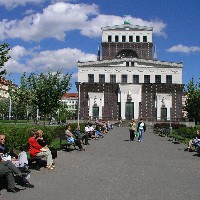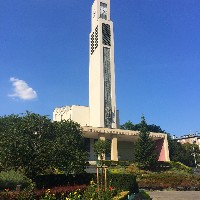Breadcrumbs navigation
From Vinohrady to Vršovice; Prague’s Modernist Churches
You may be asking what the refined and residential district of Vinohrady could possibly have in common with its neighbouring, once working-class and somewhat overlooked district of Vršovice? Any ideas? Make no mistake – this seemingly incongruous pair of Prague districts has more in common that you might think. One of the most visible points of common ground is the untypical abundance of modernist inter-war church architecture. These original, innovative and, in their time daring church buildings are now an inherent and much-admired aspect of the scintillating architectural mosaic of our capital city.
Vinohrady, as an extensive district covering the former vineyards to the east of the city centre, dates from the end of the 18th century. Today’s chic district reminiscent of Vieux Paris originated at the turn of the 19th and 20th centuries, gradually developing its orderly urban concept of historically-themed and Art Nouveau houses in rectangular tenement blocks. This also encompassed large public spaces. One of these, the Náměstí Jiřího z Poděbrad square, came to include one of the most notable modernist places of worship – the Church of the Most Sacred Heart of Our Lord. The highly esteemed Slovenian architect Jože Plečnik sought through this edifice to combine the spirit of ancient and proto-Christian temples with a 20th century church design. This he achieved in every respect. This monumental sacral work evocative of Noah’s Ark commands attention, not least by its 40-metre tower bearing the largest glass clock in the Czech Republic (7.5 metres across) and its unusual combinations of tiles and granite on the façade. No surprise then that Plečnik’s temple is latterly being considered for a place on the prestigious UNESCO World Heritage list.
About 300 metres to the south in Dykova street is another notable building, the Hus Congregational House in Vinohrady, a complex comprising a Hussite prayer house, residential building and elegant six storey tower. It was built in the 1930s by architect Pavel Janák in the then upcoming and innovative constructivist style. The said tower, which seems from a distance reminiscent of the cautionary finger of God, is an open reinforced concrete bell-tower with a spiral staircase in the middle leading to the very top. The unexpectedly modern interior of the prayer house is impressive for its well-considered layout – resembling an amphitheatre sloping toward the presbytery, with all-round good visibility of the preacher.

And now, hand on heart – how many churches do you know with their own theatre? None? Let us show you one. If you go on from our last stop further south, you will cross the Francouzská boulevard and find yourself in the self-assured Vršovice district, undeniably more rural in character. At the heart of this district, on Vršovické náměstí square, you cannot miss the unusual Hus Congregational House from 1930 by architect Karel Truksa. This one-of-a-kind multifunctional building with elements of functionalism and constructivism combines the sacred character of a temple with a theatre hall for some 300 spectators complete with rehearsal rooms, dressing rooms, make-up rooms and administrative offices. The dominant feature of the prayer house of the Czechoslovak Hussite Church is a massive, four-sided, almost 26-metre-high tower, finished off with a stylized four-sided chalice and cross.
Moreover, just a few steps away on Náměstí Svatopluka Čecha square, the white prismatic rectangular bell-tower of St Wenceslas’ Church stands lighthouse-like above the stormy-sea roof cascades of Vršovice. This jewel of Prague’s sacral modernism is considered by the experts to be one of the best functionalist religious buildings in Czechia. The author of this showpiece project of 1929 was the architect Josef Gočár, who shrewdly took advantage of the sloping terrain to create a three-tier cascade with a high semi-circular chancel. Incidentally, it is worth noting that this is the first ever Czech church built with reinforced concrete – the extensive interior makes no use of pillars or other supporting elements. No less interesting is the approach taken to lighting in the temple – the sun’s rays shine in trough wide roof windows and the light intensity increases towards the main altar, creating a perfect optical illusion of limitless space.
So much for an introduction to these no-frills, unfussy yet impressive, elegant and timeless modernist churches of the inter-war period in the Vinohrady-Vršovice agglomeration. Taking the time to see them makes for a pleasing and refreshing contrast to the ‘heavyweight’ historic architecture of central Prague.
![]() For the respective contact details and opening times see
For the respective contact details and opening times see ![]() prague.eu.
prague.eu.
Other Unmissables:
Vinohrady Water Tower![]() Korunní 66, Praha 3 – Vinohrady
Korunní 66, Praha 3 – Vinohrady ![]() prague.eu
prague.eu
A charming water tower dating from 1882, resembling a romantic folly. This fascinating technical monument was built in the neo-Renaissance style and served for many years as a part of the water infrastructure for the then Royal Vineyards district. It has since been adapted for residential use.
Kotěra’s Villa![]() Hradešínská 6, Praha 10 – Vinohrady
Hradešínská 6, Praha 10 – Vinohrady
Lovers of early 20th century modern architecture are sure to appreciate this villa, designed by and built for the renowned architect Jan Kotěra. The building combines natural masonry with rough exterior plaster and is characterized by the strict rational logic of geometric shapes.
Šaloun Studio![]() Slovenská 4, Praha 10 – Vinohrady
Slovenská 4, Praha 10 – Vinohrady ![]() prague.eu
prague.eu
The former studio of one of the most significant among Czech sculptors, Ladislav Šaloun, whose works include the Jan Hus Monument on Old Town Square, is one of the jewels of Art Nouveau architecture. It was a popular meeting place for the nation’s artists, among them Ema Destinnová, Alfons Mucha or František Bílek. Today the building is owned by the Academy of Fine Arts and used as a teaching venue for visiting tutors.
Havlíček Gardens / Havlíčkovy sady (Grébovka)
![]() Praha 2 – Vinohrady
Praha 2 – Vinohrady ![]() prague.eu
prague.eu
This park, inspired by the Italian Renaissance, has dozens of rare trees, and in addition to fountains, water cascades and ponds it has a charming artificial cave, or grotto, and a two-story neo-Renaissance villa. The grounds also include the former performance Pavilion (now the Garden Café) and the magnificent wooden gazebo, where you can enjoy the season’s wine from the vineyard growing right beneath you.
St Nicholas Church![]() Vršovické náměstí, Praha 10 – Vršovice
Vršovické náměstí, Praha 10 – Vršovice
This originally Gothic church has undergone many changes, including extensive internal modifications. It is currently one of the dominant features of the centre of Vršovice and among the oldest monuments in Prague 10.
Vršovice Chateau (“Rangherka”)![]() Moskevská 21, Praha 10 – Vršovice
Moskevská 21, Praha 10 – Vršovice ![]() prague.eu
prague.eu
The impressive neo-Renaissance building stands on the edge of the Heroldovy sady park, named after its first owner, the Italian silk merchant, Guiseppe Rangheri. Over time, the building has served as a school, a museum and as the offices of various authorities, in particular the Vršovice Town Hall. Recently, the Manor has undergone extensive renovation and serves as a home for seniors and a ceremonial hall.
Ďolíček / Sinobo Stadium Arena![]() Vršovická 31
Vršovická 31 ![]() bohemians.cz
bohemians.cz ![]() U Slavie 2a
U Slavie 2a ![]() slavia.cz
slavia.cz
With a bit of exaggeration, life in Vršovice fills-in between two football stadiums and first division clubs, Slavia Praha and Bohemians Praha 1905. The first-mentioned team plays in the Eden Arena, a modern multi-purpose stadium for up to 21000 while the latter team enthuses their fans on their legendary and more homely-sized pitch, known as “v Ďolíčku” (‘in the Hollow’).
A Break for Coffee, Lunch or Dinner:
Los v Oslu (‘The Moose in Oslo’) and the Belgian Beer Club![]() Perunova 17, Praha 3 – Vinohrady
Perunova 17, Praha 3 – Vinohrady ![]() losvoslu.cz
losvoslu.cz
This unusually named cosy and stylish restaurant serves Nordic and French cuisine, many kinds of draught Belgian and Czech beers and 50 bottled beer varieties. The popular dishes on the menu include both fresh mussels prepared in any of several ways, and Czech classics such as roast pork ribs or beef sirloin tartar.
Café V lese (‘In The Woods’)![]() Krymská 12, Praha 10 – Vršovice
Krymská 12, Praha 10 – Vršovice ![]() cafevlese.cz
cafevlese.cz
This offbeat cafe helped start the current popularity of Vršovice, or more specifically made Krymská street the epicentre of its contemporary independent culture scene. The rich cultural programme and 1970s retro interior regularly attracts a vibrant mix of patrons. The coffee shop includes a gallery and a music club.
Café Sladkovský![]() Sevastopolská 17, Praha 10 – Vršovice
Sevastopolská 17, Praha 10 – Vršovice ![]() cafesladkovsky.cz
cafesladkovsky.cz
One of the first establishments to help heal the battered visage of Vršovice. This distinctive place is inspired by the café atmosphere of the 1930s. By daylight, their breakfast, coffee or lunch is just the thing, while in the evening, Café Sladkovský becomes a bustling local bar. The hot meals are served throughout the day, with a choice of home-made desserts.
How to Get There:
Metro A, Jiřího z Poděbrad
Tram 2, 7, 10, 16, 23, 30, 91 – Vinohradská vodárna stop
Tram 4, 13, 22, 97, 99 – Vršovické náměstí stop
Author: Jan Pomykal - Web Content and Publishing Department




